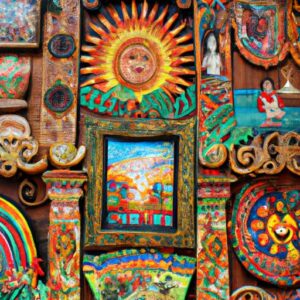Introduction
In a world where art holds the power to transcend boundaries and evoke emotions, art appreciation plays a vital role in our lives. It allows us to connect with diverse cultures, challenge our perspectives, and indulge in the beauty that surrounds us. But have you ever wondered what sparked the revolution of reproduction in large numbers? How did this transformative concept make art accessible to the masses? Let’s embark on a journey to uncover the intriguing factors that made reproduction in large numbers first possible for art appreciation.
Art appreciation, in its essence, is the ability to recognize, interpret, and value artistic expressions. It enables us to delve into the minds of artists, decipher their intentions, and immerse ourselves in the stories they tell. However, for centuries, art was confined to a privileged few who could afford to possess original masterpieces. The birth of reproduction in large numbers shattered this exclusivity, opening up a new era of artistic accessibility.
Reproduction in large numbers refers to the process of creating multiple copies of an artwork through various techniques. It revolutionized the art world by making it feasible to distribute artworks widely and affordably. Artists, collectors, and enthusiasts eagerly embraced this groundbreaking concept, as it allowed them to share and appreciate art on an unprecedented scale.
The advent of reproduction techniques marked a significant turning point. Early methods involved painstakingly copying artworks by hand, limiting the number of reproductions that could be created. However, the introduction of lithography, a printing technique in the late 18th century, revolutionized the art reproduction process. It enabled artists to create high-quality prints with remarkable precision, replicating the original artwork’s essence. This breakthrough technique laid the foundation for widespread art reproduction.
As we delve deeper into the exploration of what made reproduction in large numbers first possible, we’ll unravel the advancements in reproduction techniques, the accessibility and distribution of artworks, and the profound impact of mass production on art appreciation. Join me on this captivating journey to understand how the art world transformed, paving the way for a revolution in art accessibility and appreciation.
The Evolution of Art Appreciation
A. Historical Overview of Art Appreciation
To truly understand the impact of reproduction in large numbers on art appreciation, we must first delve into the historical roots of this cherished practice. Art appreciation traces its origins back to ancient civilizations, where art served as a means of communication, storytelling, and cultural expression. From the exquisite cave paintings of Lascaux to the awe-inspiring masterpieces of the Renaissance, art has always held a special place in human society.
Throughout history, art appreciation evolved alongside societal transformations. In the Middle Ages, art primarily served religious purposes, with intricate frescoes adorning cathedrals and churches. It wasn’t until the Renaissance, with its emphasis on humanism and individualism, that art began to be appreciated for its aesthetic value as well. This marked a pivotal shift in the way society perceived and valued artistic creations.
B. Significance of Art Reproduction in the Art World
Art reproduction emerged as a crucial turning point in the art world, allowing for wider dissemination and appreciation of artworks. Prior to reproduction techniques, the scarcity of original artworks limited their reach to a privileged few. Reproduction changed the game by making it possible for art lovers from all walks of life to admire and own copies of renowned masterpieces.
With the advent of lithography and later advancements in photography, artists and collectors realized the potential of reproduction to democratize art. Reproductions enabled individuals to experience the beauty and emotion of beloved artworks without the constraints of time, location, or financial means. This newfound accessibility fostered a deeper appreciation for art, as more people could engage with various artistic styles, movements, and cultural influences.
Moreover, art reproduction played a pivotal role in preserving the legacy of artists and their works. By creating multiple copies, reproductions safeguarded artworks from the ravages of time, ensuring their longevity and cultural significance. This preservation allowed future generations to continue to appreciate and study the masterpieces of the past, nurturing a continuous dialogue between artists, art enthusiasts, and art historians.
As we move forward in our exploration, we will delve into the advancements in reproduction techniques, the accessibility and distribution of artworks, and the profound impact of mass production on art appreciation. Join me as we uncover the fascinating factors that propelled the revolution of reproduction in large numbers, forever transforming the art world.
Advancements in Reproduction Techniques
Art reproduction techniques have come a long way, evolving hand in hand with technological advancements. This section will delve into the fascinating journey of early reproduction techniques and the transformative impact of lithography and photography on art reproduction and appreciation.
A. Exploration of Early Reproduction Techniques
In the early days, reproducing artworks was a laborious and meticulous process. Skilled artists painstakingly copied paintings by hand, striving to capture the essence of the original masterpiece. However, this method was time-consuming and limited the number of reproductions that could be created. It also posed challenges in maintaining accuracy and consistency across multiple copies.
B. Introduction of Lithography and Its Impact on Art Reproduction
The introduction of lithography in the late 18th century revolutionized the art reproduction landscape. Lithography, a method of printing from a flat surface, allowed artists to create reproductions with remarkable precision and quality. Using a limestone or metal plate, artists transferred their artwork onto the printing surface, which could then be replicated multiple times.
Lithography enabled artists to capture intricate details, vibrant colors, and subtle nuances of the original artwork. It bridged the gap between the original and the reproduced, making art more accessible to a wider audience. This technique not only enhanced the fidelity of reproductions but also made it possible to distribute them more efficiently.
C. Emergence of Photography and Its Influence on Art Appreciation
The emergence of photography further revolutionized the world of art reproduction. With the invention of the camera, artists and enthusiasts gained a powerful tool to capture and reproduce artworks with unprecedented accuracy. Photographs allowed for the creation of high-quality prints that closely resembled the original artwork, enabling wider distribution and consumption.
Photography not only facilitated the reproduction of paintings but also opened doors to capturing sculptural works and three-dimensional art forms. It provided a means to document and archive artworks, preserving them for future generations. The ability to capture and reproduce art in such detail pushed the boundaries of art appreciation, allowing viewers to engage with artworks they might never have the opportunity to see in person.
As we explore the advancements in reproduction techniques, it becomes evident that lithography and photography played pivotal roles in making art more accessible and appreciated. These techniques set the stage for a new era of art reproduction, paving the way for mass production and the democratization of art consumption. Let’s continue our journey to understand how accessibility and distribution further transformed the art world.
Accessibility and Distribution
Art is no longer confined to the walls of exclusive galleries or the homes of the affluent. Reproduction in large numbers has democratized art, making it accessible to a broader audience. Let’s delve into the factors that have contributed to the increased availability and distribution of reproduced artworks, as well as the impact this accessibility has had on art appreciation.
A. Increased availability of reproduced artworks
Reproduction in large numbers has shattered the limitations of scarcity and rarity that were once associated with art. Through the power of replication, artworks can reach a wider audience, transcending geographical boundaries and cultural barriers. Art enthusiasts can now easily obtain prints, posters, and other reproduced forms of artwork, allowing them to decorate their spaces with pieces that resonate with their aesthetic preferences.
This increased availability not only caters to the demands of art lovers but also allows artists to gain recognition and exposure. Artists can now reach a global audience, showcasing their talent and gaining visibility through reproduced artworks. This newfound accessibility has become a stepping stone for emerging artists, enabling them to establish their presence in the art world.
B. Role of technology in facilitating art distribution
Technology has played a pivotal role in revolutionizing the distribution of art. The advent of the internet, social media platforms, and online marketplaces has transformed the way we engage with art. Digital platforms have become virtual galleries, hosting a vast collection of reproduced artworks that can be easily accessed by anyone with an internet connection.
Artists and art enthusiasts can now connect directly, transcending traditional gatekeepers in the art industry. Online platforms provide a space for artists to showcase their creations, while art lovers can explore and purchase reproduced artworks without the need for intermediaries. This direct interaction between artists and their audience fosters a sense of community, encouraging dialogue and appreciation for art.
C. Impact of reproduction on art accessibility to the masses
Reproduction in large numbers has undoubtedly made art more accessible to the masses. Through affordable prints, posters, and digital reproductions, individuals from diverse backgrounds can engage with and appreciate art without financial constraints. Museums and educational institutions can also utilize reproduced artworks to enhance visual learning experiences, exposing students to a wide range of artistic expressions.
Art accessibility sparks curiosity, fosters creativity, and encourages dialogue. It allows individuals to develop their own artistic tastes and preferences, empowering them to engage critically with the art they encounter. The democratization of art through reproduction has forged a deeper connection between art and society, making it a shared experience that transcends socioeconomic boundaries.
In the next section, we will explore the profound relationship between mass production and artistic influence, exploring how the reproduction of artworks has shaped popular culture and societal norms. Join me as we unravel the impact of mass reproduction on the artistic landscape.
Mass Production and Artistic Influence
Examination of the Relationship between Mass Production and Art Appreciation
The advent of mass production in the realm of art has undeniably transformed the way we perceive and appreciate artistic creations. The ability to reproduce artworks in large quantities has democratized art, allowing it to reach a broader audience. But how does mass production impact art appreciation? Does it dilute the value of original artworks, or does it enhance our understanding of artistic expression?
Mass production enables artworks to be widely disseminated, making them accessible to individuals who may not have had the opportunity to experience art otherwise. This accessibility fosters a deeper appreciation for art, as it allows a diverse range of individuals to engage with different styles, movements, and cultural expressions. By breaking down barriers, mass production has the potential to ignite a passion for art in individuals who may have previously felt excluded from the art world.
Influence of Reproduced Artworks on Popular Culture and Societal Norms
Reproduced artworks have permeated popular culture, leaving an indelible mark on societal norms and influencing the way we perceive art. These reproductions have adorned the walls of homes, offices, and public spaces, becoming a part of our daily lives. They have become symbols of status, personal expression, and even political statements.
Reproduced artworks have the power to evoke emotions, spark conversations, and challenge societal conventions. They serve as visual reminders of our shared cultural heritage and can shape our understanding of history, social issues, and individual identities. Through the widespread circulation of reproduced artworks, popular culture is enriched, fostering a collective appreciation for art that transcends traditional boundaries.
Critics’ Perspectives on the Impact of Mass Reproduction on Artistic Integrity
While mass reproduction has undoubtedly expanded the reach of art, it has also sparked debates regarding its impact on artistic integrity. Critics argue that the proliferation of reproduced artworks diminishes the uniqueness and value of original pieces. They question whether mass-produced replicas can truly capture the essence and depth of the artist’s original creation.
Moreover, critics contend that mass production may lead to the commodification of art, where artworks become mere consumer goods rather than vehicles for artistic expression. The emphasis on profitability and market demand could potentially compromise artistic vision, as artists may be inclined to create works that are more commercially viable rather than truly innovative or thought-provoking.
In light of these criticisms, it is essential to recognize the dynamic relationship between mass production and artistic integrity. While mass reproduction may pose challenges, it also presents opportunities for artists to engage with a wider audience, explore new mediums, and experiment with innovative techniques. The impact of mass reproduction on artistic integrity ultimately depends on how artists, collectors, and society as a whole navigate the delicate balance between accessibility and preserving the essence of creative expression.
Conclusion
In conclusion, the concept of reproduction in large numbers has played a pivotal role in revolutionizing art appreciation. What was once limited to a privileged few has now become accessible to the masses, transcending geographical and socioeconomic boundaries. The ability to reproduce artworks in large quantities has transformed the art world, making it possible for people from all walks of life to engage with and appreciate art.
Throughout history, advancements in reproduction techniques have made it possible to replicate artworks with incredible accuracy and detail. From the early days of laborious hand-copying to the introduction of lithography and photography, each development has contributed to the democratization of art. These techniques have not only preserved the integrity of the original artworks but have also made it possible for replicas to be shared and enjoyed worldwide.
The accessibility and distribution of reproduced artworks have been greatly enhanced in the digital age. Technology has allowed for the seamless sharing and dissemination of art, transcending physical barriers and reaching a global audience. The internet has become a virtual gallery, where art enthusiasts can explore and appreciate a vast collection of reproduced artworks from different periods and styles.
Mass production of artworks, while criticized by some for potentially diluting artistic integrity, has undeniably influenced popular culture and societal norms. Reproduced artworks have become iconic symbols, shaping fashion, interior design, and even personal expression. They have become a part of our collective visual language, influencing our perception of beauty and aesthetics.
As we reflect on the factors that made reproduction in large numbers first possible for art appreciation, we can recognize its profound impact on our cultural landscape. The ability to appreciate and engage with art on a mass scale has deepened our understanding of different artistic movements, bridged cultural gaps, and enriched our lives.
In this ever-evolving digital age, reproduction in large numbers continues to shape the way we interact with art. It allows us to explore the rich tapestry of human creativity, connecting us to the past, present, and future. So, let us cherish the accessibility and beauty that reproduction in large numbers has brought to art appreciation, and let us continue to celebrate and be inspired by the diverse expressions of human imagination.
Join me in embracing this art appreciation revolution, where the world of art is at our fingertips, waiting to be explored, cherished, and shared.





